An Improved Quadtree Sampling Method for InSAR Seismic Deformation Inversion
Abstract
1. Introduction
2. The Saliency-Based Quadtree Sampling Algorithm
- (1)
- Set size for and for (search window). is a sequence and (1 ≤ ≤ , is the length of sequence). For example, ,;
- (2)
- Expand the normalized deformation graph by and fill it with null values;
- (3)
- Calculate the average and of the non-null points of and ;
- (4)
- Calculate the saliency ;
- (5)
- The saliency of all points in window is assigned as ;
- (6)
- Move and until the entire deformation graph is traversed to obtain ;
- (7)
- Repeat steps 2–6 with different values;
- (8)
- Calculate the average of multiple saliency graphs .
3. Simulation Experiments
3.1. Simulation Experiment 1: Comparison the Sampling Results between SQS and QS
3.2. Simulation Experiment 2: Linear Inversion Results Based on SQS and QS
3.3. Simulation Experiment 3: The Resolution of the Inversion Results Based on SQS and QS
4. Case Study
4.1. Background
4.2. Sampling Results of Co-Seismic Deformations of the Dingri Event
4.3. Source Parameters of the Dingri Event
5. Discussion
6. Conclusions
Supplementary Materials
Author Contributions
Funding
Data Availability Statement
Acknowledgments
Conflicts of Interest
References
- Massonnet, D.; Rossi, M.; Carmona, C.; Adragna, F.; Peltzer, G.; Feigl, K.; Rabaute, T. The displacement field of the Landers earthquake mapped by radar interferometry. Nature 1993, 364, 138–142. [Google Scholar] [CrossRef]
- Biggs, J.; Wright, T.J. How satellite InSAR has grown from opportunistic science to routine monitoring over the last decade. Nat. Commun. 2020, 11, 1–4. [Google Scholar] [CrossRef]
- Simons, M. Coseismic Deformation from the 1999 Mw 7.1 Hector Mine, California, Earthquake as Inferred from InSAR and GPS Observations. Bull. Seism. Soc. Am. 2002, 92, 1390–1402. [Google Scholar] [CrossRef]
- He, P.; Wen, Y.; Ding, K.; Xu, C. Normal Faulting in the 2020 Mw 6.2 Yutian Event: Implications for Ongoing E–W Thinning in Northern Tibet. Remote Sens. 2020, 12, 3012. [Google Scholar] [CrossRef]
- Ross, Z.E.; Idini, B.; Jia, Z.; Stephenson, O.L.; Zhong, M.; Wang, X.; Zhan, Z.; Simons, M.; Fielding, E.J.; Yun, S.-H.; et al. Hierarchical interlocked orthogonal faulting in the 2019 Ridgecrest earthquake sequence. Science 2019, 366, 346–351. [Google Scholar] [CrossRef]
- Pritchard, M.E.; Simons, M.; Rosen, P.A.; Hensley, S.; Webb, F.H. Co-seismic slip from the 1995 July 30Mw = 8.1 Antofagasta, Chile, earthquake as constrained by InSAR and GPS observations. Geophys. J. Int. 2002, 150, 362–376. [Google Scholar] [CrossRef]
- Jonsson, S. Fault Slip Distribution of the 1999 Mw 7.1 Hector Mine, California, Earthquake, Estimated from Satellite Radar and GPS Measurements. Bull. Seism. Soc. Am. 2002, 92, 1377–1389. [Google Scholar] [CrossRef]
- Lohman, R.B.; Simons, M. Some thoughts on the use of InSAR data to constrain models of surface deformation: Noise structure and data downsampling. Geochem. Geophys. Geosyst. 2005, 6. [Google Scholar] [CrossRef]
- Wang, C.; Ding, X.; Li, Q.; Jiang, M. Equation-Based InSAR Data Quadtree Downsampling for Earthquake Slip Distribution Inversion. IEEE Geosci. Remote. Sens. Lett. 2014, 11, 2060–2064. [Google Scholar] [CrossRef]
- Wang, L.; Gao, H.; Feng, G.; Xu, W. Source parameters and triggering links of the earthquake sequence in central Italy from 2009 to 2016 analyzed with GPS and InSAR data. Tectonophysics 2018, 744, 285–295. [Google Scholar] [CrossRef]
- Gao, H. Research on InSAR Seismic Source Parameter Inversion and the Triggering Relationship between Earthquake. Master’s Thesis, East China University of Technology, Nanchang, China, 2018. (In Chinese with English Abstract). [Google Scholar]
- Itti, L.; Koch, C.; Niebur, E. A model of saliency-based visual attention for rapid scene analysis. IEEE Trans. Pattern Anal. Mach. Intell. 1998, 20, 1254–1259. [Google Scholar] [CrossRef]
- Zhai, Y.; Shah, M. Visual attention detection in video sequences using spatiotemporal cues. In Proceedings of the 14th Annual ACM International Conference on Multimedia—MULTIMEDIA’06, Barbara, CA, USA, 21–25 October 2006; pp. 815–824. [Google Scholar] [CrossRef]
- Goferman, S.; Zelnik-Manor, L.; Tal, A. Context-Aware Saliency Detection. IEEE Trans. Pattern Anal. Mach. Intell. 2011, 34, 1915–1926. [Google Scholar] [CrossRef] [PubMed]
- Achanta, R.; Estrada, F.; Wils, P.; Süsstrunk, S. Salient Region Detection and Segmentation. In Proceedings of the Lecture Notes in Computer Science, Sydney, NSW, Australia, 14–18 September 2008; pp. 66–75. [Google Scholar]
- Boomgaard, R.V.D.; Van Balen, R. Methods for fast morphological image transforms using bitmapped binary images. CVGIP Graph. Model. Image Process. 1992, 54, 252–258. [Google Scholar] [CrossRef]
- Haralick, R.M.; Linda, G.S. Computer and Robot Vision; Addison-Wesley: Boston, MA, USA, 1992; Volume I, pp. 28–48. [Google Scholar]
- Gonzalez, R.C.; Woods, R.E.; Eddins, S.L. Digital Image Processing Using MATLAB; Pearson Education India: Chennai, India, 2004. [Google Scholar]
- Okada, Y. Surface deformation due to shear and tensile faults in a half-space. Bull. Seismol. Soc. Am. 1985, 75, 1135–1154. [Google Scholar]
- Wang, L.Y.; Gao, H.; Feng, G.C. Triggering relations and stress effects analysis of two Mw> 6 earthquakes in southwest Taiwan based on InSAR and GPS data. Acta Geod. Cartogr. Sin. 2019, 48, 1244. [Google Scholar] [CrossRef]
- Yin, A.; Harrison, T.M. Geologic Evolution of the Himalayan-Tibetan Orogen. Annu. Rev. Earth Planet. Sci. 2000, 28, 211–280. [Google Scholar] [CrossRef]
- Li, P.; Qing, S.Q.; Chen, K. On the seismogenic process of the 25 April 2015 Mw7.8 earthquake and future earthquake situation. China J. Geophys. 2015, 58, 1827–1833, (In Chinese with English Abstract). [Google Scholar]
- Wang, Y.Z.; Chen, S.; Chen, K. Source Model and Tectonic Implications of the 2020 Dingri Mw5.7 Earthquake Constrained by InSAR Data. Earthquake 2021, 41, 116–128, (In Chinese with English Abstract). [Google Scholar]
- Feng, G.; Li, Z.; Shan, X.; Zhang, L.; Zhang, G.; Zhu, J. Geodetic model of the 2015 April 25 Mw 7.8 Gorkha Nepal Earthquake and Mw 7.3 aftershock estimated from InSAR and GPS data. Geophys. J. Int. 2015, 203, 896–900. [Google Scholar] [CrossRef]
- Egoda, K.; Ekiyota, T.; Epokhrel, R.M.; Echiaro, G.; Ekatagiri, T.; Esharma, K.; Ewilkinson, S. The 2015 Gorkha Nepal Earthquake: Insights from Earthquake Damage Survey. Front. Built Environ. 2015, 1, 8. [Google Scholar] [CrossRef]
- Deng, Q.D.; Zhang, P.Z.; Ran, Y.K.; Yang, X.P.; Min, W.; Chu, Q.Z. Basic characteristics of active tectonics in China. Sci. China Ser. D Earth Sci. 2002, 32, 1020–1030, (In Chinese with English Abstract). [Google Scholar]
- He, L.; Feng, G.; Li, Z.; Feng, Z.; Gao, H.; Wu, X. Source parameters and slip distribution of the 2018 M 7.5 Palu, Indonesia earthquake estimated from space-based geodesy. Tectonophysics 2019, 772, 228216. [Google Scholar] [CrossRef]
- Sudhaus, H.; Jónsson, S. Improved source modelling through combined use of InSAR and GPS under consideration of correlated data errors: Application to the June 2000 Kleifarvatn earthquake, Iceland. Geophys. J. Int. 2009, 176, 389–404. [Google Scholar] [CrossRef]
- Ding, K.; He, P.; Wen, Y.; Chen, Y.; Wang, D.; Li, S.; Wang, Q. The 2017 Mw 7.3 Ezgeleh, Iran earthquake determined from InSAR measurements and teleseismic waveforms. Geophys. J. Int. 2018, 215, 1728–1738. [Google Scholar] [CrossRef]
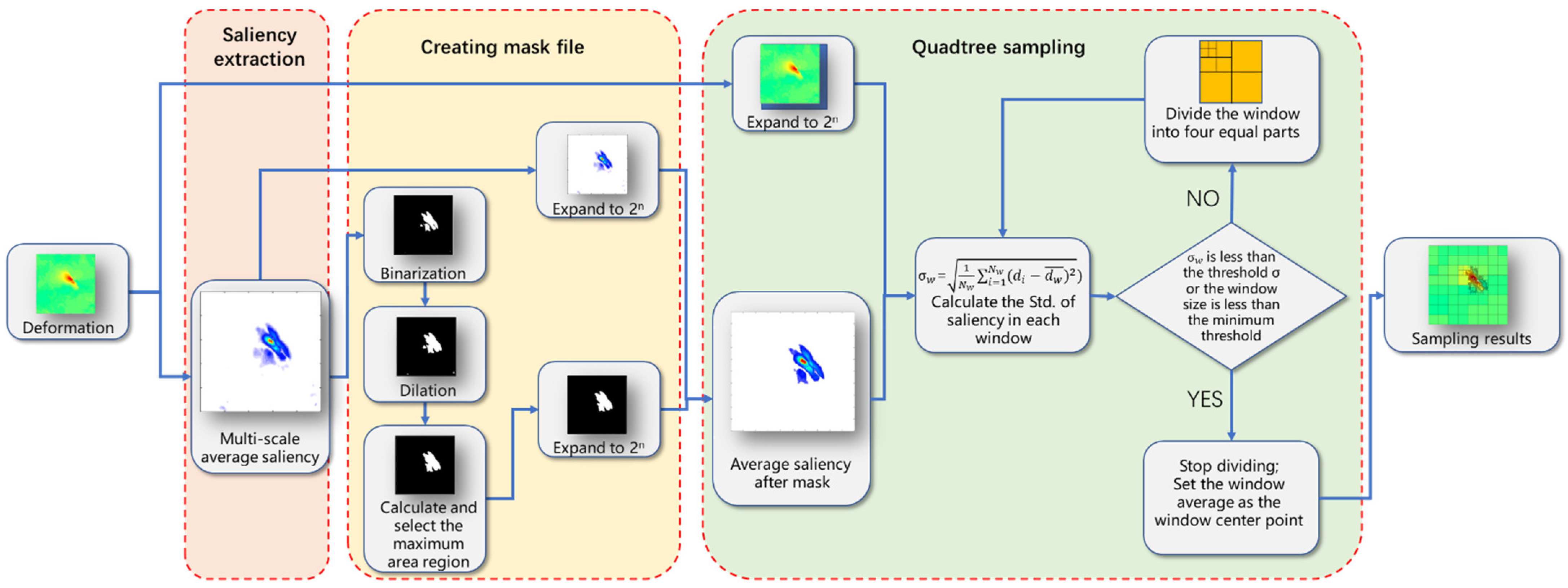
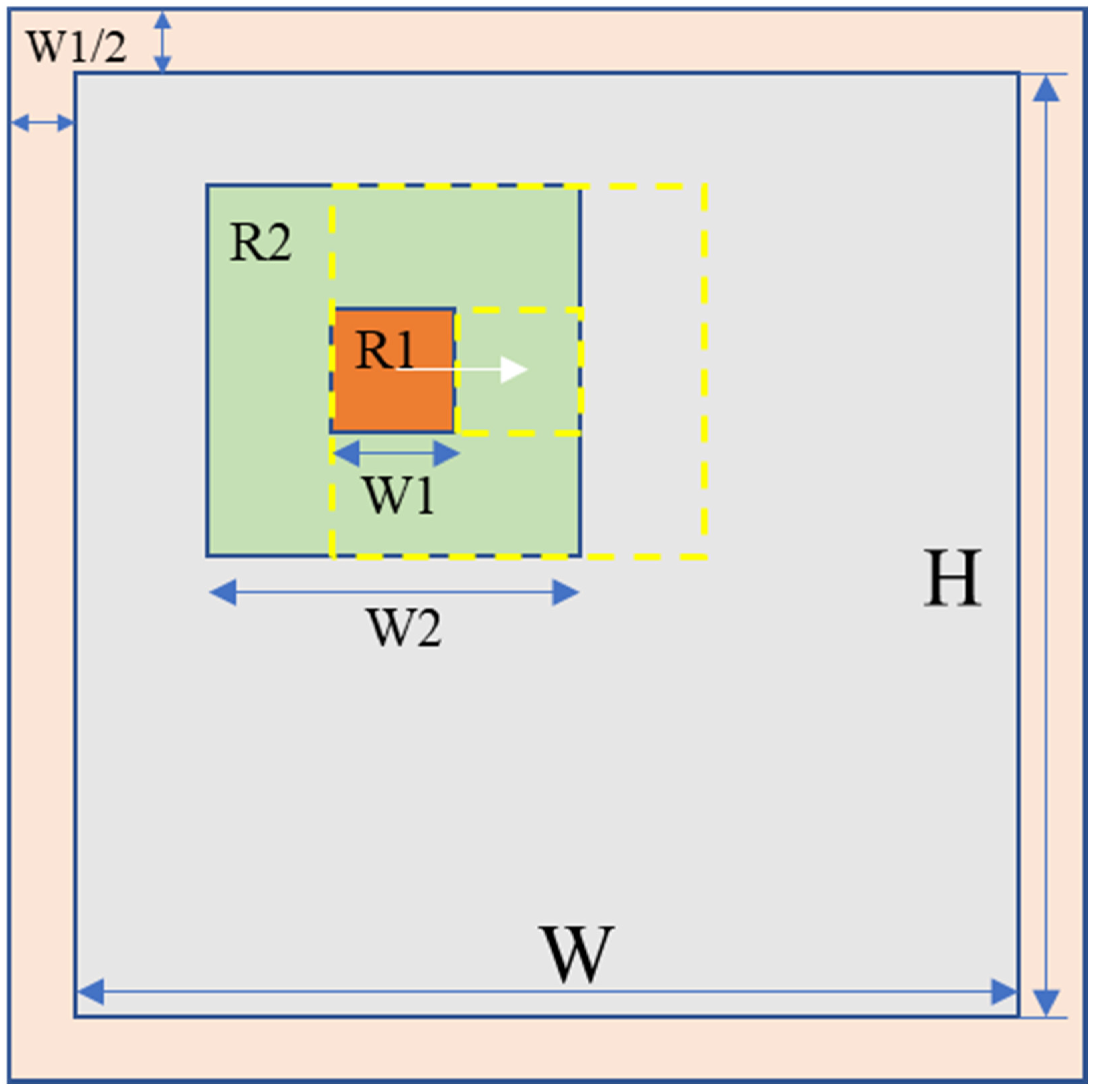
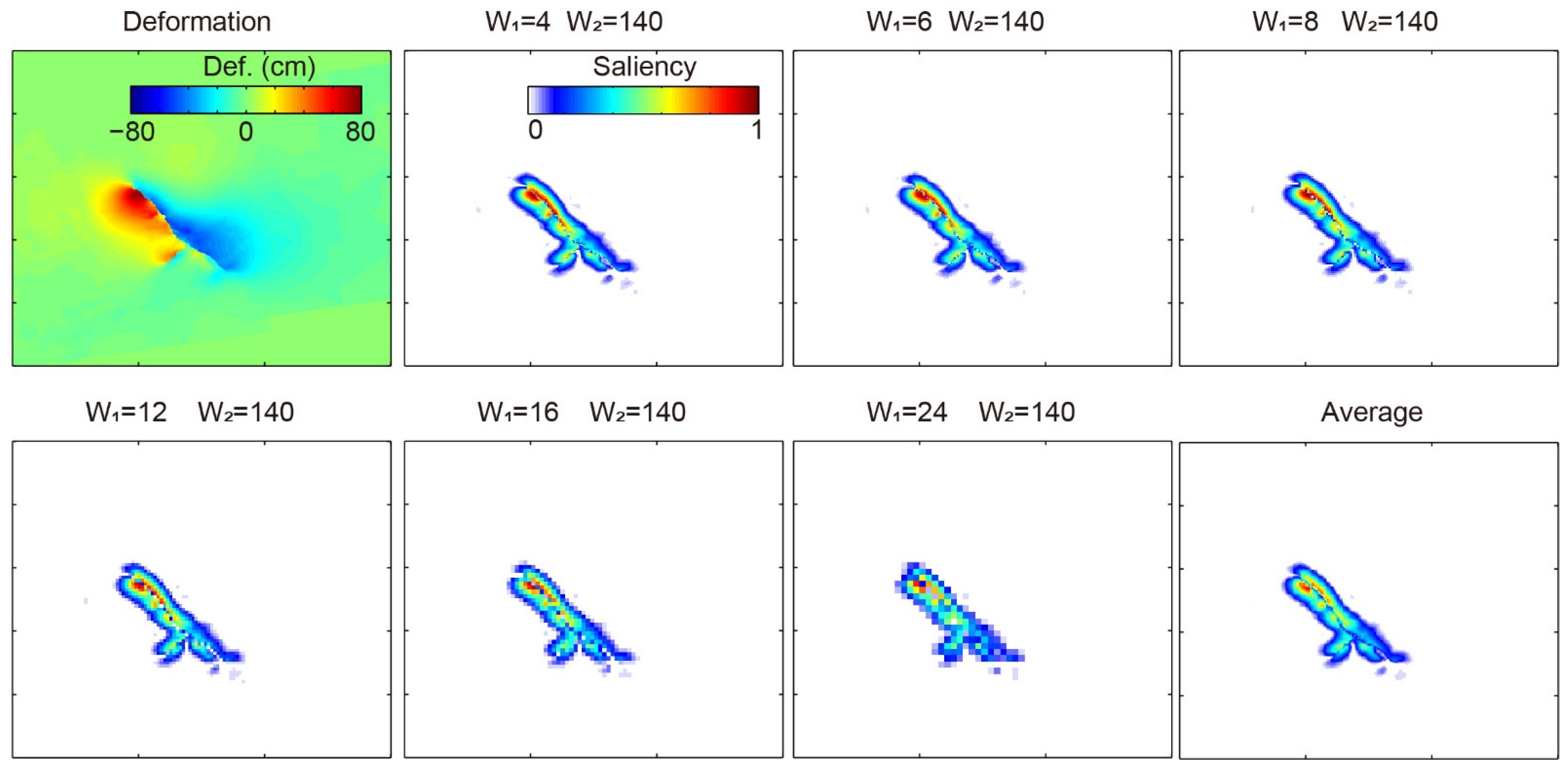
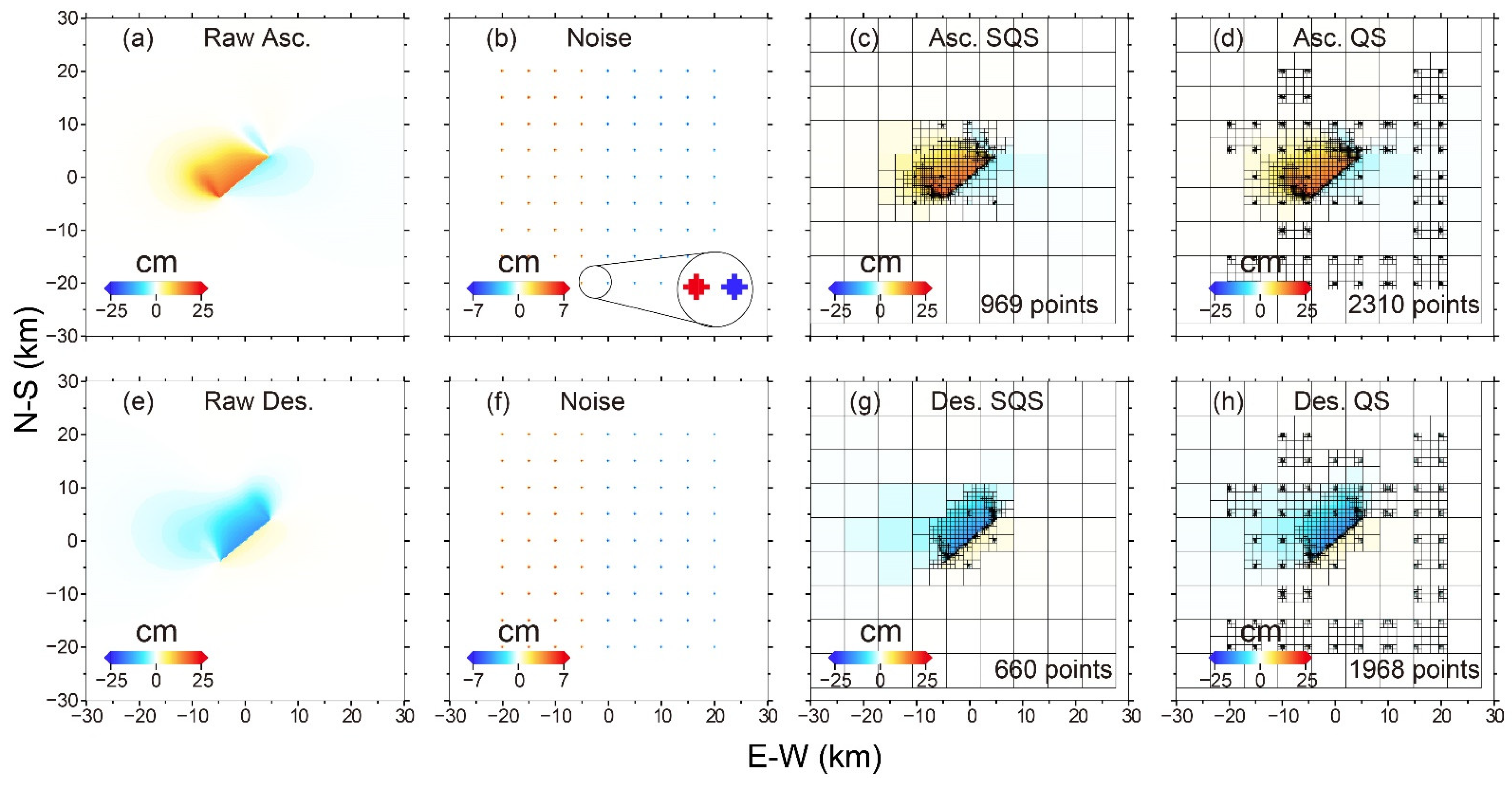
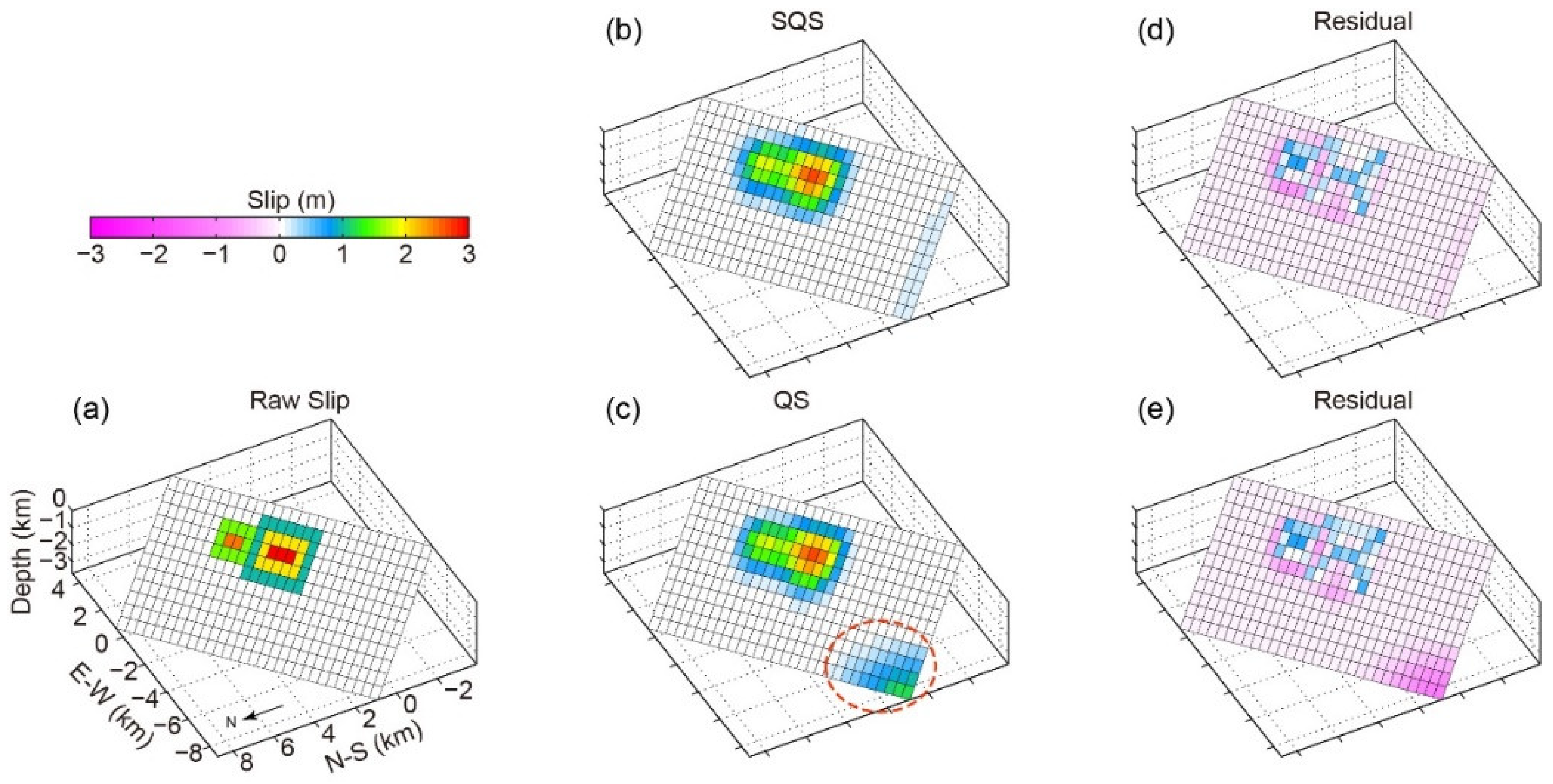

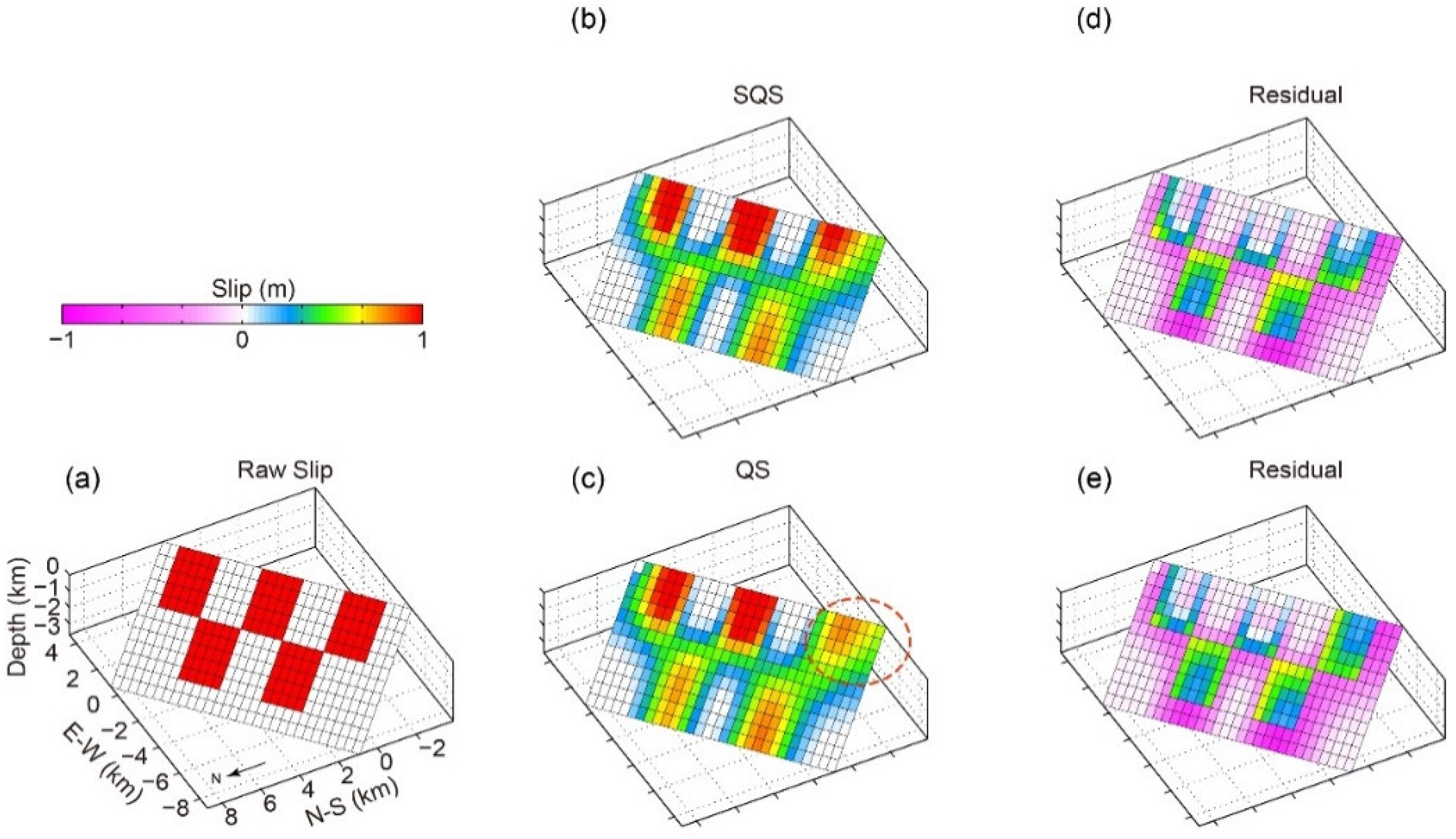
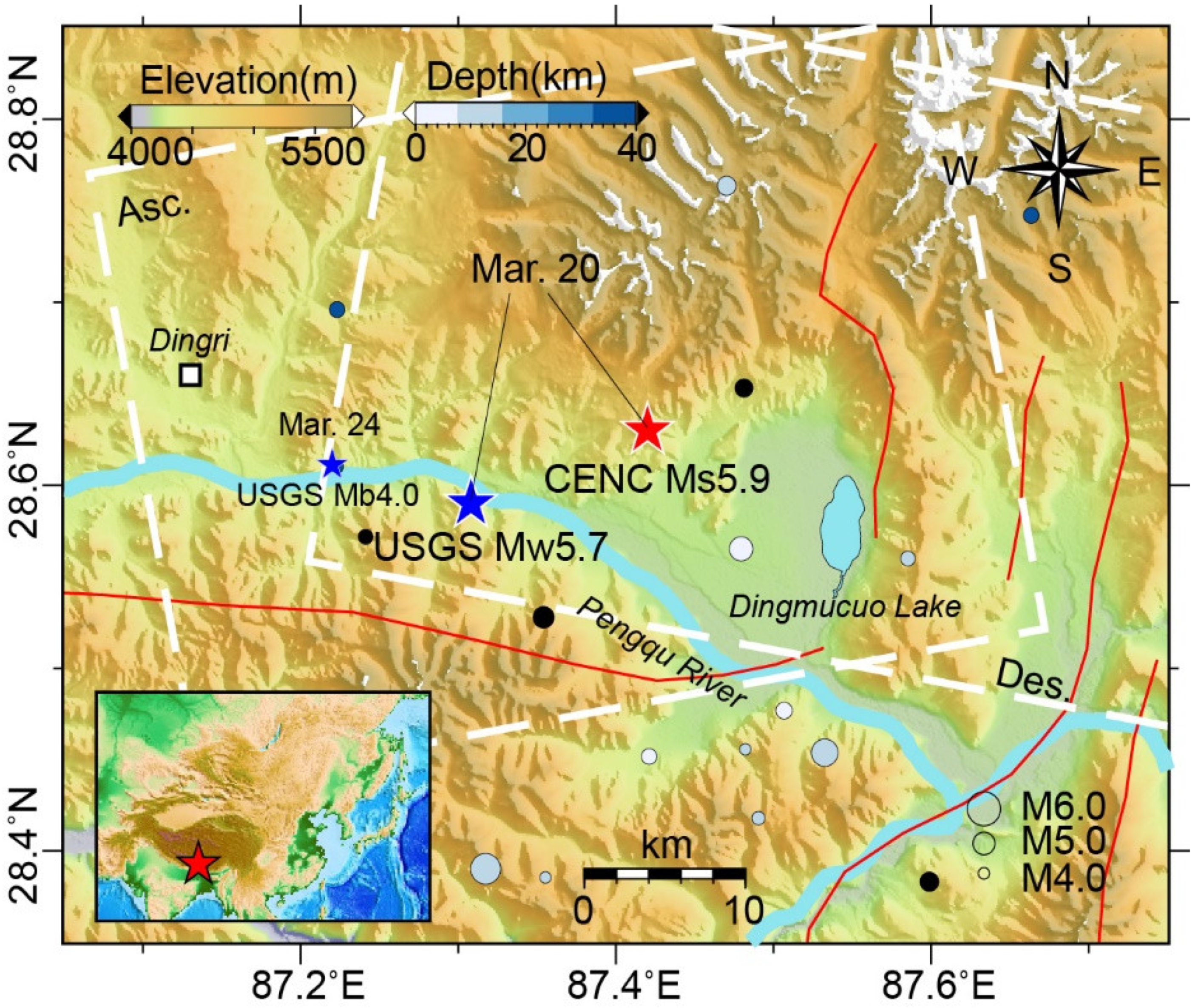

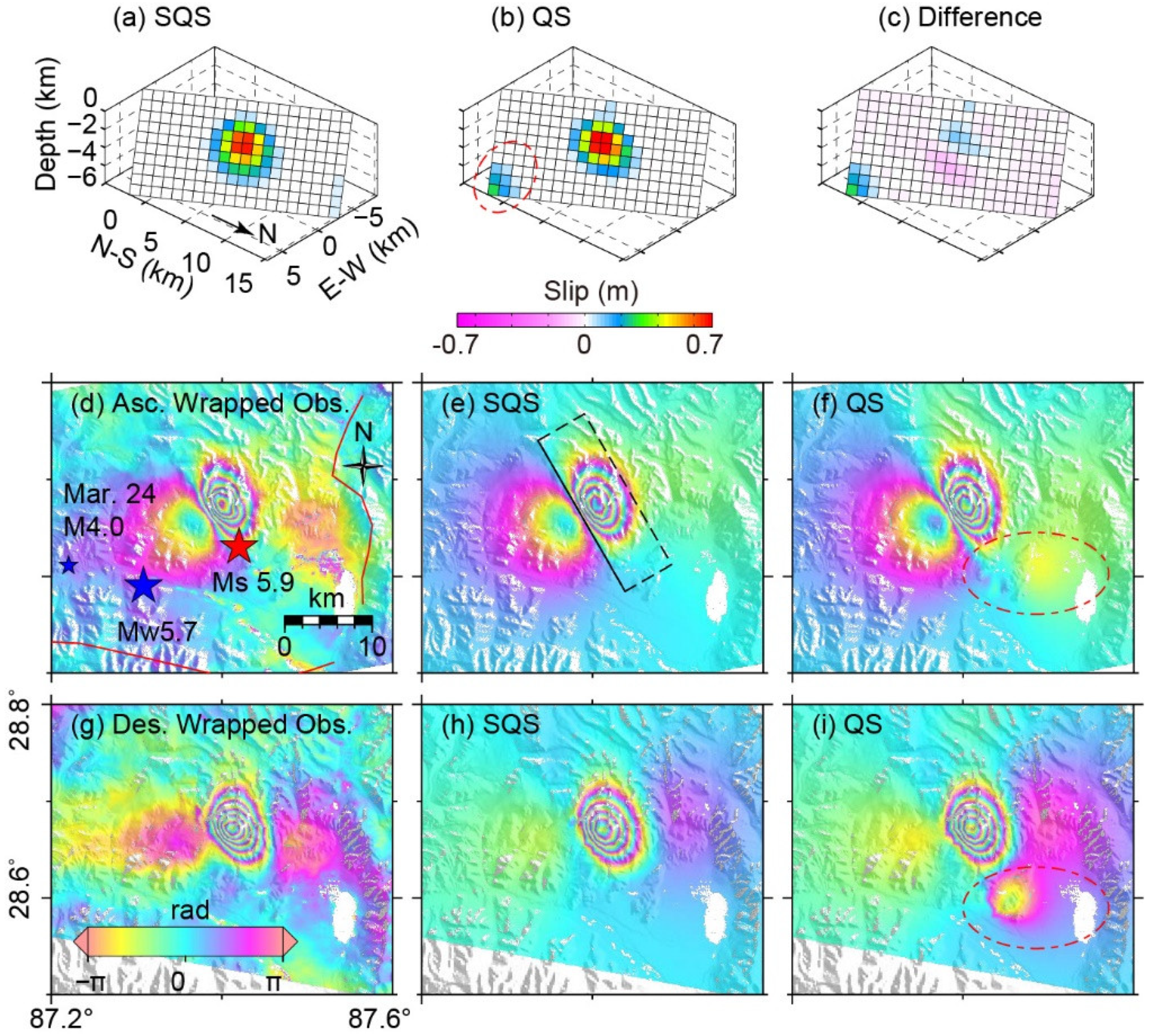
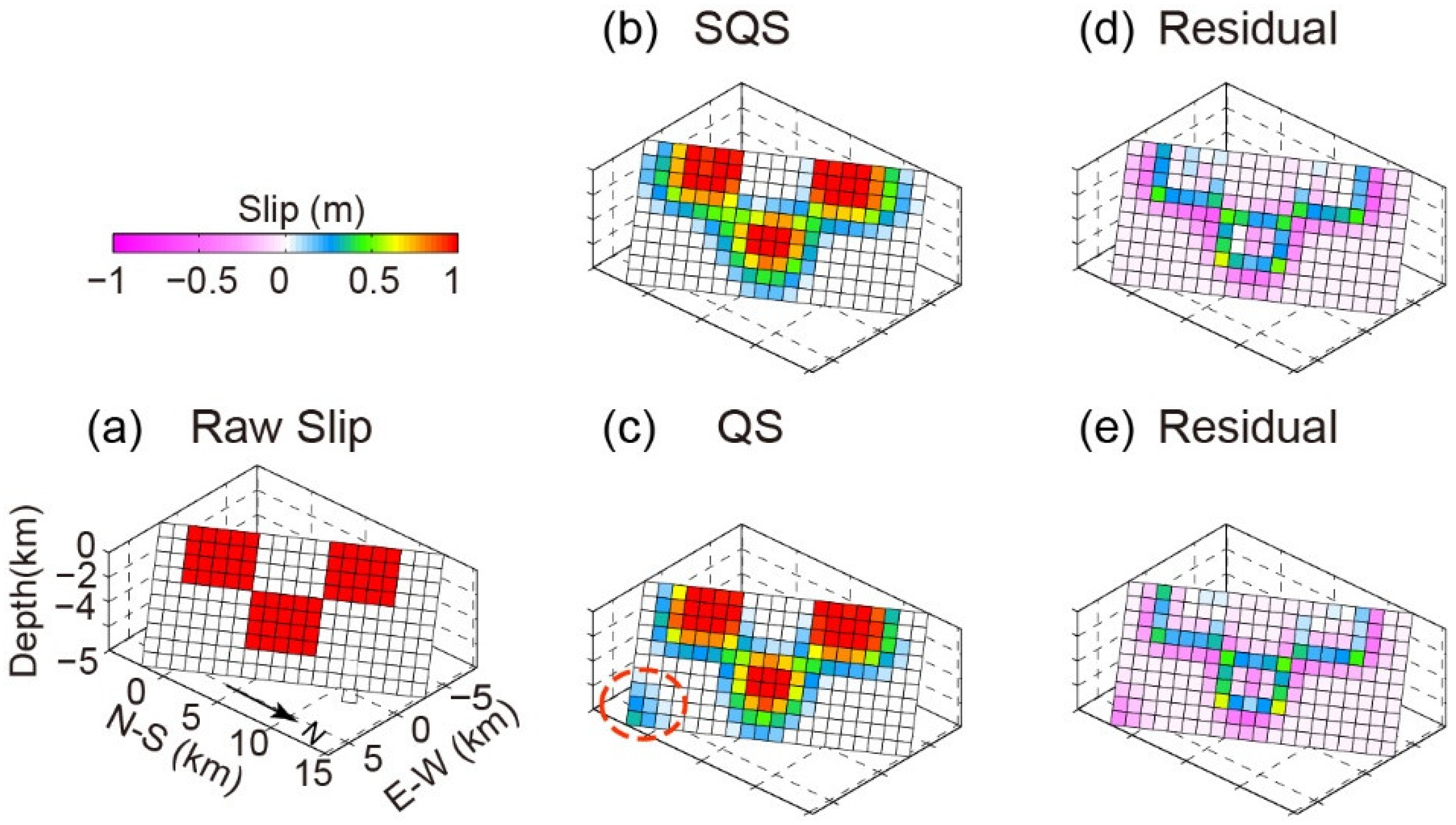
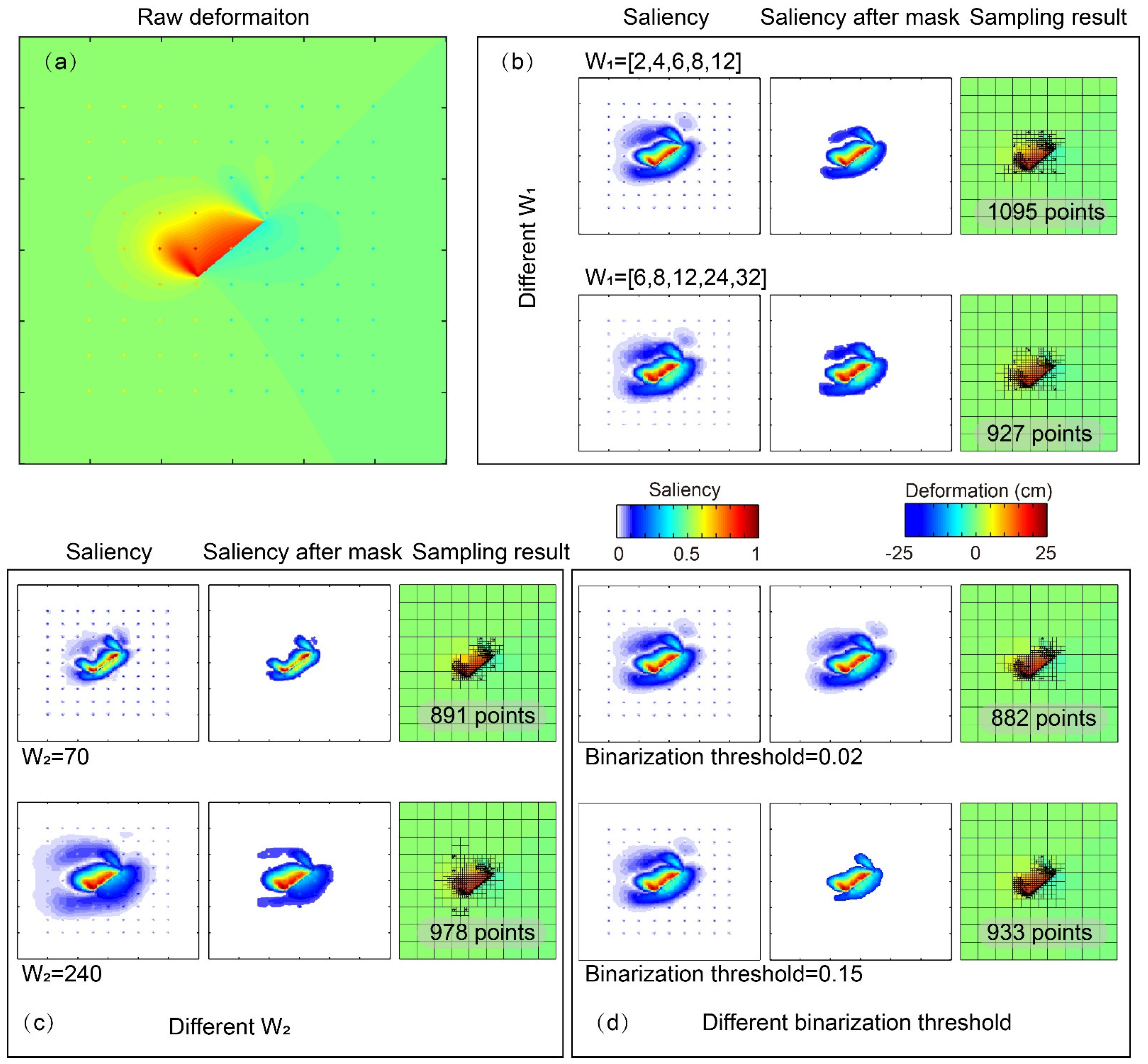
| Length (km) | Width (km) | Depth 1 (km) | Strike (°) | Dip (°) | Rake (°) | Strike Slip (m) | Dip Slip (m) | Mw | |
|---|---|---|---|---|---|---|---|---|---|
| SE 1 | 12.23 | 7.28 | 0 | 30 | 50 | 0 | 0.42 | 0 | 6.00 |
| SE 2 2 | / | / | 0 | 30 | 50 | −90 | 0 | Figure 5a | 5.79 |
| SE 3 2 | / | / | 0 | 30 | 50 | −90 | 0 | Figure 7a | 6.26 |
| Event | Method | Window Segmentation | Saliency | |||||
|---|---|---|---|---|---|---|---|---|
| Min window | Max window | Segmentation threshold | Binarization threshold | W1 | W2 | Expansion times | ||
| SE 1 Ascending | SQS | 2 | 64 | 0.03 | 0.08 | [4 6 8 12 16 24] | 140 | 1 |
| QS | 2 | 64 | 0.5 cm | / | ||||
| SE 1 Descending | SQS | 2 | 64 | 0.03 | 0.1 | [4 6 8 12 16 24] | 140 | 1 |
| QS | 2 | 64 | 0.5 cm | / | ||||
| SE 2 Ascending | SQS | 2 | 64 | 0.03 | 0.02 | [4 6 8 12 16] | 50 | 1 |
| QS | 2 | 64 | 1.7 cm | / | ||||
| SE 2 Descending | SQS | 2 | 64 | 0.03 | 0.02 | [4 6 8 12 16] | 50 | 1 |
| QS | 2 | 64 | 2.7 cm | / | ||||
| Dingri event Ascending | SQS | 8 | 128 | 0.03 | 0.03 | [8 12 16 24 32 48 64] | 200 | 1 |
| QS | 8 | 128 | 0.3 cm | / | ||||
| Dingri event Descending | SQS | 8 | 128 | 0.03 | 0.03 | [8 12 16 24 32 48 64] | 200 | 1 |
| QS | 8 | 128 | 0.3 cm | / | ||||
| Method | Length (km) | Width (km) | Depth 1 (km) | Strike (°) | Dip (°) | Rake (°) | Strike Slip (m) | Dip Slip (m) | Mw |
|---|---|---|---|---|---|---|---|---|---|
| QS | 3.7 | 2.7 | 2.4 | 330 | 55 | −113 | 0.41 | 0.97 | 5.63 |
| SQS | 3.9 | 2.9 | 2.2 | 330 | 52 | −96 | 0.09 | 0.81 | 5.59 |
Publisher’s Note: MDPI stays neutral with regard to jurisdictional claims in published maps and institutional affiliations. |
© 2021 by the authors. Licensee MDPI, Basel, Switzerland. This article is an open access article distributed under the terms and conditions of the Creative Commons Attribution (CC BY) license (https://creativecommons.org/licenses/by/4.0/).
Share and Cite
Gao, H.; Liao, M.; Feng, G. An Improved Quadtree Sampling Method for InSAR Seismic Deformation Inversion. Remote Sens. 2021, 13, 1678. https://doi.org/10.3390/rs13091678
Gao H, Liao M, Feng G. An Improved Quadtree Sampling Method for InSAR Seismic Deformation Inversion. Remote Sensing. 2021; 13(9):1678. https://doi.org/10.3390/rs13091678
Chicago/Turabian StyleGao, Hua, Mingsheng Liao, and Guangcai Feng. 2021. "An Improved Quadtree Sampling Method for InSAR Seismic Deformation Inversion" Remote Sensing 13, no. 9: 1678. https://doi.org/10.3390/rs13091678
APA StyleGao, H., Liao, M., & Feng, G. (2021). An Improved Quadtree Sampling Method for InSAR Seismic Deformation Inversion. Remote Sensing, 13(9), 1678. https://doi.org/10.3390/rs13091678








